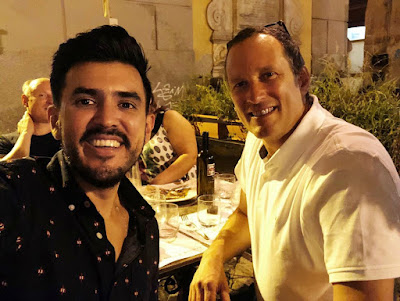Hello word...!!
I hope that you are
liking the blog. This is the fifth entry that I am making and just between us,
I am getting used to it 😊.
However, you have let me do all the “talking” and have not interacted with me
which was one of the goals I had when I started blogging. Thus, I encourage you
to share your thoughts, ideas, likes, dislikes under the comment tab at the end
of the post.
On this occasion, I
am writing about the two-work visits I had to the Fatigue Carrousel which is an
Accelerated Pavement Testing (APT) facility owned by The French Institute of
Science and Technology for Transport, Development and Networks (IFSTTAR). For those who know
about what APT is and have hear about what IFSTTAR does then the next lines might
be redundant; on the other hand, for those who are curious, specially for those
with a pavement engineering orientation, I hope that you will continue searching
on your own and perhaps in the near future we could have a discussion.
Figure 1: IFSTTAR Nantes.
John Metcalf under
NCHRP: Synthesis of Highway Practices 235 “Application
of Full-Scale Accelerated Pavement Testing” in Chapter 1, page 3 defines APT
as “the controlled application of a
prototype wheel loading, at or above the appropriate legal load limit to a
prototype or actual, layered, structural pavement system to determine pavement
response and performance under a controlled, accelerated accumulation of damage
in a compressed time period” (Metcalf,
1996)” while IFSTTAR is a public research institution created in 2011 as a
result from the merger of The French National Institute for Transport and
Safety Research (INRETS) and the French Central Laboratory of Roads and Bridges
(LCPC). IFSTTAR is composed by five departments: MAST, GERS, COSYS, TS2, and AME which can be
seen by clicking the links.
There is some
background information regarding the project that I am omitting in order to not
make the post too extensive. Having say that, from now on, I will be a little
bit more technical in order to describe what was the real purpose of my visit
to Nantes. During the first seven months of my research I focused on literature
review on piezoelectric materials, sensors, pavement performance, pavement
modelling, damage modelling, basically in everything that could be related to
link pavement responses to predict its future condition. In parallel, during
one meeting with my research supervisor, he told me that our piezoelectric
sensors, from now on PZT, were installed on the Fatigue Carrousel and that I
should get ready to handle it. Until that point, I have not seen the PZT’s so I
was more than ready to travel to Nantes to get the data and to have a brief
introduction of the experiment. Figure
below shows the first I saw both PZT Carrousel.
Figure
2: PZT developed at Michigan State University (MSU),
USA.
Figure 3: Fatigue Carrousel during installation.
APT was carried out
between November 2017 and February 2018 where 1.0 million loads were applied. Temperature
was measured at different depths (0.0, 50.0, and 100.0 millimetres). Wandering was
studied through eleven positions, equally spaced, with a total length of 1.05 meters;
position six was at the centre with radius 19.00 meters. Traffic followed a Gaussian
distribution where position six bear 22% of it. Following figures show how data was treated,
from importing raw measurements to define an average signal, to then plot
maximum values across the transverse position where wandering can be seen.
Figure 4: Raw voltage after 500,000 load repetitions at radius 19.00 meters.
Figure 5: Average voltage after 500,000 load repetitions at radius 19.00 meters.
Figure 6: Strain responses from TML Gauge at 100 mm depth.
Figure 7: Voltage responses from PZT at 100 mm depth.
Finally, I cannot end this post without my moment of fame,
respective selfie, on the Carrousel. In case you wonder, I used MATLAB
(90%) and Excel Macros (10%) for processing the data.
Figure 8: Your blogger with his respective selfie.
Long nights, such as this one, have gotten
me closer to the main goal, The PhD.! Stay tuned and see you soon pavement
lovers!
Mario Manosalvas Paredes.



























